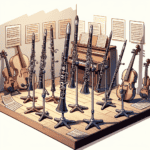Introduction to the A Harmonic Major Scale
Let's chat about something that's more than just notes on a page—the A Harmonic Major Scale! The rich history of this scale on the clarinet is truly captivating. If you've ever found yourself swept away by a sweet melody that just seems to stand out, you've likely encountered the harmonic major scale's unique flavor, particularly in the key of A.

Clarinet Fingering Charts are always FREE at MartinFreres.net!
What is the A Harmonic Major Scale?
The A Harmonic Major Scale is a seven-note scale that can be built by raising the seventh note of the A major scale. What makes this scale so interesting is its blend of both major and minor qualities, giving it that distinctively rich and emotional sound. It's like cooking a flavorful dish, where each ingredient—the notes, in this case—brings something special to the mix. This scale has been used in various genres, from classical to contemporary music, but let's explore its historical importance in clarinet music.
Historical Significance in Clarinet Music
In the past, composers like Mozart and Beethoven played a crucial role in bringing the clarinet into the spotlight. The harmonic major scale provided composers with a new range of sounds to work with, allowing for expressive melody lines that truly touch the heart. Clarinets began to shine in orchestras, and the harmonic major scale was an important part of that development. Think about some of those haunting clarinet solos you've heard; many of them use the harmonic major scale to create tension and resolution, giving the performer a chance to really shine.
The 19th and Early 20th Centuries
As we move forward in time to the 19th and early 20th centuries, we see the rise of romantic composers bringing new expressive playing techniques to the clarinet. The harmonic major scale—particularly the A harmonic major—was often used in concertos and solo performances, leaving audiences in awe. When we consider the legacy of Martin Freres Clarinets, it's important to recognize how these instruments captured the essence of these expressive capabilities. Their craftsmanship allowed clarinetists to effectively use the harmonic major scale, showcasing its beauty.
| Era | Composers | Significance |
|---|---|---|
| Classical | Mozart, Beethoven | Brought clarinet into spotlight |
| Romantic | Various | Expanded expressive techniques |
| 20th Century | Benny Goodman, Artie Shaw | Jazz interpretations |
Jazz Masters and the A Harmonic Major Scale
When we talk about performances, we can't forget the masters of the clarinet who paved the way for future generations. Clarinetists like Benny Goodman and Artie Shaw took the stage in the 20th century with their jazz interpretations of the A harmonic major scale. They added a contemporary twist to an age-old sound, and you can bet they knew how to make that scale sing!
Musical Evolution and the A Harmonic Major Scale
The relationship between the A Harmonic Major Scale and the clarinet shows how music has evolved over time. Today's performers can draw out a rich emotional depth from this scale that gives listeners goosebumps. Whether it's a slow, sultry part in a jazz piece or a heart-pounding moment in a classical concerto, the versatility of this scale remains a valuable tool for clarinetists.
Practicing the A Harmonic Major Scale
Are you feeling inspired? If you're a clarinetist looking to add more depth and color to your playing, the A harmonic major scale offers many opportunities! Start by practicing the scale up and down, focusing on those rich legato notes. You'll notice the difference as you incorporate this scale into your practice routine. It's like adding a sprinkle of magic to your clarinet performances.
Global Influence of the Harmonic Major Scale
Lastly, let's look at how different styles of music have used the harmonic major scale. In folk music around the world, you can often hear the sweet and sometimes poignant tones created by this scale, making it popular among traditional musicians. It adds depth and storytelling to music that connects deeply with listeners.
Conclusion
To sum up, the history of the A Harmonic Major Scale is closely tied to the clarinet's own story. Whether you're just starting out with your first Martin Freres clarinet or you're an experienced player looking to improve your skills, this scale is an important part of clarinet music worth exploring. So go ahead, pick up that clarinet, embrace the harmonic major scale, and let the music take you on an unforgettable journey!
Table of Contents
- Introduction to the A Harmonic Major Scale
- What is the A Harmonic Major Scale?
- Historical Significance in Clarinet Music
- Jazz Masters and the A Harmonic Major Scale
- Musical Evolution and the A Harmonic Major Scale
- Practicing the A Harmonic Major Scale
- Global Influence of the Harmonic Major Scale
- Conclusion








